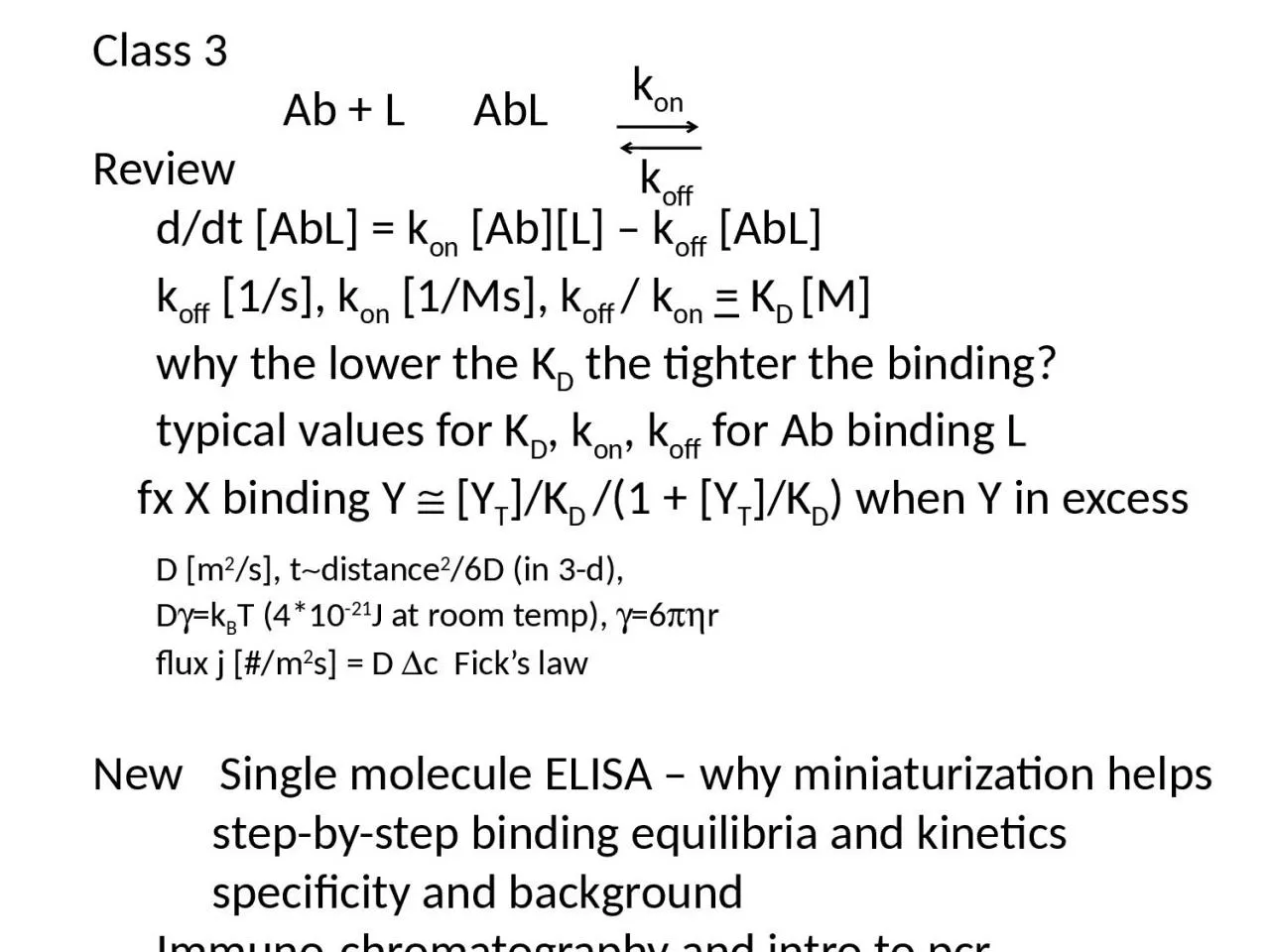/


AbL Review d dt AbL k on Ab L k off AbL k off 1s k on 1 Ms k off k on K D M why the lower the K ID: 920763
Download Presentation The PPT/PDF document "Class 3 Ab + L" is the property of its rightful owner. Permission is granted to download and print the materials on this web site for personal, non-commercial use only, and to display it on your personal computer provided you do not modify the materials and that you retain all copyright notices contained in the materials. By downloading content from our website, you accept the terms of this agreement.
Slide1
Class 3 Ab + L AbL Review d/dt [AbL] = kon [Ab][L] – koff [AbL] koff [1/s], kon [1/Ms], koff / kon = KD [M] why the lower the KD the tighter the binding? typical values for KD, kon, koff for Ab binding L fx X binding Y @ [YT]/KD /(1 + [YT]/KD) when Y in excess D [m2/s], t~distance2/6D (in 3-d), Dg=kBT (4*10-21J at room temp), g=6phr flux j [#/m2s] = D Dc Fick’s lawNew Single molecule ELISA – why miniaturization helps step-by-step binding equilibria and kinetics specificity and background Immuno-chromatography and intro to pcr
k
on
k
off
Slide2Single-molecule ELISA assay Nat Biotech 28, 598 (2010)
Slide3Why does miniaturization help?Enzyme catalytic rate kcat ~100 substrate molecules/s per enzyme moleculeNeed threshold conc of dye ~100nM to see it the smaller the vol, the higher the conc how many molecules/50fl for 100nM? how many can one enz. molecule make in 30s? what are dimensions of 50fl volumefluorescence = advantage =emit longer wavelength than absorbedcan block bright excitation lightthat would otherwise -> signal6*1023-7-15*50=3*103[50x10-15*10-3m3 ] @ (4mm)3
Slide4Why measure PSA?Why might it beuseful to measure[PSA] after prost-x?Why might it notbe useful?Sensitivity of SiMoALOD std assayNat Biotech 28, 598 (2010)
Slide5Fig. 2A J Immunol Methods 378:102 (2012) [AbL]2 - [AbL] {[LT] + [AbT] + KD} + [LT] [AbT] = 0or, since Ab in excess, [AbL]/[LT] @ [AbT]/KD / (1 + [AbT]/KD)given [AbT] @ 2nM
Slide6Fig.3 J Immunol Methods 378:102 (2012)Is Ab or L in excess?Then t @ koff-1 / (1 + [AbT]/KD) Simplify [AbT]/KD Do results agree with figure? Are reactions B, C near equilibrium at 1000s? *What is equil [AbL]/[LT]? Does this agree with * ?The one in excess
Slide7Fig. 4 J Immunol Methods 378:102 (2012)What step of rxn is this modeling? Why so flat?Then fx AbL in complex @ [Det AbT]/KD / (1 + [Det AbT]/KD) independent of [AbL]assumes KD of interaction = 1nMFor which symbols is detection Ab in excess?
Slide8Fig. 5 J Immunol Methods 378:102 (2012)What step is this modeling?What is the KD of this interaction?What is in excess? What is formula? Does this explain why almost all the points are 100%?
Slide9Specificity and backgroundBackground can come from non-tgt protein in sample or signal-generating species (e.g. enzyme)How many specific binding steps are there in label-free assay, like SPR?Suppose capture Ab binds tgt protein 107x more tightly (in terms of KD) than it binds high conc protein like albumin in biological sample [alb]plasma @ mMWhat fx of capture Ab binds albumin? KD @ 10-9+7, so [alb]/KD / (1 + [alb]/KD) @ 0.1
Slide10What would this do in SPR assay?What would happen in sandwich assay? What would be [alb] after it is captured (wrongly) by capture Ab? If detection Ab also binds alb with mM affinity, what fraction of capture Ab-alb complexes bind detection Ab? If capture Ab is nM in device , [cap Ab-alb] ~0.1nMIf [det Ab] = nM, it is in excess over bound albumin, so f @ [det Ab]/KD /(1 + [det Ab]/KD) = 10-7so 1011 capture Ab to start would -> 104 det Ab from alb
Slide11This is likely << threshold for signal in standard ELISA, but would -> signal in SiMoABackground in SiMoA was ~1% of beadsPcr is similar to sandwich immunoassays in that 2 specific binding events are required for signal (exponential amplification of tgt DNA)Biology often uses binding of multiple proteins to increase specificity of reactions
Slide12Lateral flow immunochromatography assays Common format for home tests (e.g. HCG - pregnancy) and now many medical lab testsimmobil. capt. AbNeg controlDet Ab on membrane but not attached;gets picked up and carried along by sample
Slide13Questions – how many gold particles at what density for easily visible line? why are they visible – ? just concentration or something special about plasmon resonance, which gives them colorFlipped left-right from schematic; don’t know why C and T are diff. colors
Slide14Polymerase chain reaction = method to replicate piece of DNA “exponentially”1. DNA polymeraseN strands are “anti-parallel” adds bases to 3’-end pol requires primer to start synthesisprimertemplate
Slide15Short pieces of DNA (“oligo”nucleotides ~1-100 bases) can be chemically synthesizedN , commercially available for <$1/base for 100nmol = 6x1016 molecules, serve as “primers” to start DNA synthesis at particular place on DNA template
Slide16Pcr amplification of DNA using thermostable DNA polymerase (e.g. Taq pol)forward primertemplatestrand (A)copy strand (B)Taq polMelt DNA (94oC), cool (60oC) to anneal primers, extend (72oC)reverse primernew strand A
Slide17Old and new templates are not destroyed by melting, so repeated cycles of melting and polymerization ->1 -> 2 -> 4 -> 8 -> … -> 2n copies of DNA region lyingbetween 2 primer-annealing sites on initial templatePolymerase copies ~1000b/min => ~1 hour for 230 =1010-fold amp. of a kb piece of DNAhttp://www.youtube.com/watch?v=_YgXcJ4n-kQhttp://www.dnalc.org/ddnalc/resources/animations.html
Slide18Note target DNA seq., to ends of which oligos bind in right orientation, is amplified exponentially 2N, (N=#cycles)Non-tgt DNA, to which oligos may bind weakly, may be copied but only increases arithmetically ~NDifferent from signal amplification, e.g. use of enzymes that generate multiple fluors or dyes from each bound ligand in ELISA; here you make multiple copies of DNA ligand if there is 1 present to start with
Slide19Next week – first homework dueWill begin paper that considers effects of flow and diffusion in sensors that use microfluidics – see BlackboardConsiders “simple” revisions to model of binding kinetics when analyte concentrations can’t be considered spatially uniform